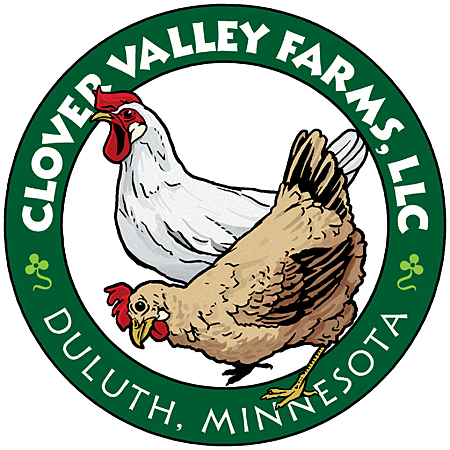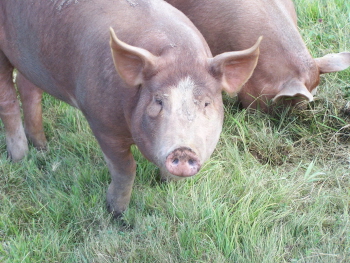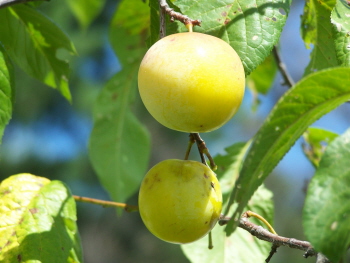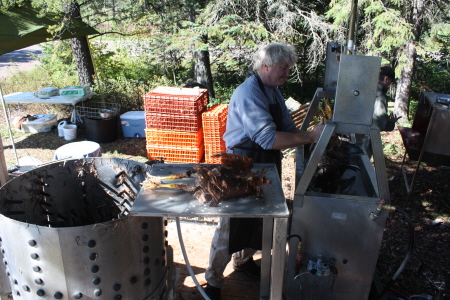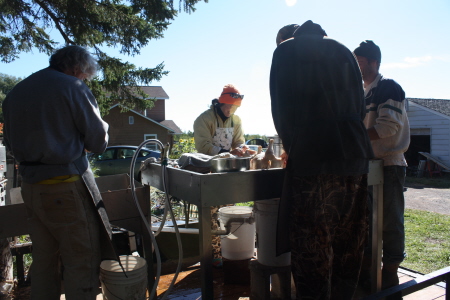Poultry Harvest & Processing
In 2010, Jeff and Cindy purchased a mobile poultry processing unit. Prior to that, they rented the “chicken bus” from the Sustainable Farming Association’s Lake Superior Chapter. They have not had birds processed at off-farm facilities due to distance and cost (see Marketing > Models > Direct Sales). While access to a rented mobile unit was helpful during their first years of poultry operation, they found its availability became limiting as their operation expanded. With their own unit, for example, they could plan early-season processing of ducks and late-season processing of turkeys. Their customers had been asking them to produce turkeys for years, but they were unable to do so until they had their own equipment. The capital cost was high at around $14,000, but they mounted the equipment on a trailer and are making plans to rent out the equipment, thereby creating another revenue stream for their farm.

Spotlight on: Outreach Jeff and Cindy would like their mobile poultry processing unit to become a community resource. They are working on a rental protocol and accompanying manual. In 2010, they lent the unit to two other farmers as a way of learning what issues arise when others use the equipment. Renters would be required to spend at least one day processing with Jeff and Cindy before being allowed to rent the unit.
|
Now with their own processing equipment, plus the knowledge gained from several years of production, they can plan out a staggered schedule for the growing season that maximizes efficiency. Ducks, for example, can be put out on pasture as early as April; with only 7 weeks’ growth until processing, Cindy and Jeff can be mostly finished with duck production before broiler production ramps up. Besides spreading out the labor involved in processing, this staggered approach allows them to cycle different species through the brooder at different times. This keeps equipment needs to a minimum and distributes husbandry tasks throughout the season. Cindy and Jeff kept their 2010 schedule similar to previous years while they adjusted to having their own mobile processing unit, but then planned to solidify a duck/early broiler/late broiler/turkey rotation through their production and processing regime.
Educator’s Perspective: Resource Tip Feed withdrawal is an important issue in poultry processing, as it reduces the amount of food in the birds’ digestive tracts and thus the potential for carcass contamination if the digestive tract is torn during processing. Withdrawal times can vary based on several factors, and producers need to find the right balance for their situation. The key is to empty the digestive tract without sacrificing live weights or carcass yields. Optimizing Feed Withdrawal Programs is an extension bulletin, written by Kristi Thompson and Todd Applegate and published by Purdue University. Feed Withdrawal: A Practical Look at Its Effect on Intestinal Emptying, Contamination, and Yield is an article written by Stan Savage, a University of Georgia Extension Specialist and made available at the Manitoba Agriculture, Food, and Rural Initiatives Web site. A Picture Guide of Chicken Feed Withdrawal, by Carlyle Bennett, is another article from the Manitoba Agriculture, Food, and Rural Initiatives Web site. |
Jeff and Cindy have learned that, like so many aspects of farming, many of the choices they need to make come down to personal preference. The SFA mobile unit was equipped with killing “cones,” while the unit they purchased has a killing “cabinet.” They haven’t seen a significant difference in wing breakage between the two types of equipment. Cornish Broilers are especially prone to wing breakage, and Jeff and Cindy have worked to minimize that problem in other ways. To minimize wing breakage during processing, they explored the use of large rubber bands (like broccoli bands) to keep the birds’ wings close to their bodies. They also explored the use of rubber highway cones, which are softer and have more “give” than steel cones. Neither of those options worked well for them. By looking further, they found that most wing breakage was occurring when the birds were being collected from the pens, and more careful handling has greatly reduced the incidence. Some wing breakage does still occur during processing; Jeff and Cindy have found that having two people at the killing station (one to kill and one to hold birds until they stop flapping) is the best solution. They do still prefer the killing cabinet over the killing cones, because it involves fewer steps in moving birds to the scalder and thus saves time. They also feel it contains blood better and facilitates clean-up.
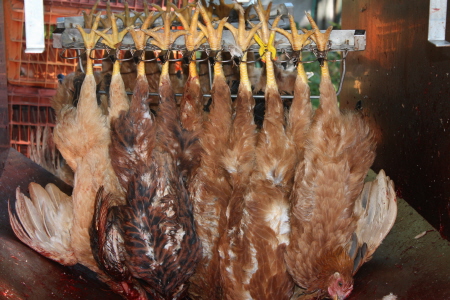
A “killing cabinet” is part of Jeff and Cindy’s mobile processing unit. It is simply a metallic box-like structure with a floor, ceiling, and walls but open on both ends. Birds are hung by their feet on shackles that initially hang inside the cabinet at one end. Hanging them upside down has a calming effect, allowing the processor to slit their throats quickly and accurately. Jeff and Cindy do not use gas stunning. The birds bleed out inside the cabinet. The shackles hang on an angled rack, so that any movement by the birds causes them to slide down the rack to the other end of the cabinet. The floor is V-shaped, funneling blood into a bucket at the other end, where the heads are removed before scalding.
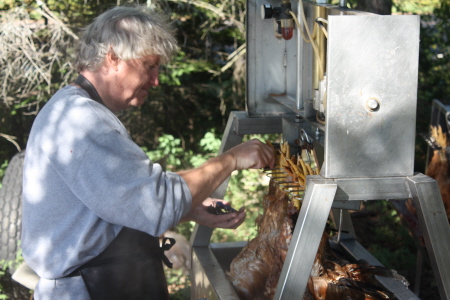
The shackles from the killing cabinet also fit the scalder, allowing quick and easy transfer of the birds to the next step in processing.
Cindy and Jeff have also found there are important differences among species in terms of processing. It seems every year they tweak something about their production plans based on what they learn during processing. Some differences are obvious. For instance, you can fit fewer turkeys into the plucker than chickens, affecting overall processing time. Other lessons are more iterative. In 2009, for example, they processed Red Broilers, for which they have always raised both males and females, at 11 weeks. They ended up with a lot of 2-lb birds, whereas most customers prefer birds around 4½ lbs. In 2010, they let Red Broilers grow until 14 weeks, and then saw a lot of aggression between males starting around 12 weeks. The 2010 observations made them ponder raising only male Red Broilers, because they grow larger than females, and going back to processing them at 11 weeks, to achieve the goal of a more consistent-sized bird with limited intra-flock aggression. At the same time, they learned of another breed, the Red Ranger, which another farmer’s study showed to have a better growth rate while maintaining good foraging behavior on pasture. In 2011, then, they took a combined approach, substituting Red Broilers with Red Rangers and raising males only. They also modified their idea of raising birds to a specific number of weeks. Instead, they selected birds to process by live weight, letting one batch go an extra week, and they ended up with more consistent finished weights (around 4 lbs).
Besides all the lessons learned about broilers, they have learned that when it comes to processing, ducks are a whole other story. Their pin feathers can be difficult and time-consuming to remove, requiring a LOT of extra soap in the scalder and excessive plucking time if the birds are processed past 7 weeks.
Educator’s Perspective: Resource Tip The Niche Meat Processor Assistance Network (NMPAN) is a national network of people and organizations (university extension, government agencies, and non-profit groups) creating and supporting appropriate-scale meat processing infrastructure for niche meat markets. Small and mid-sized plants can lack capacity, equipment, appropriate inspection status, and the human and financial capital to upgrade or expand. NMPAN assists processors, producers, buyers, regulators, and others by coordinating, distributing, and developing information and resources to improve access to processing infrastructure and the long-term stability of niche meat markets. Small-scale Poultry Processing, by Anne Fanatico and published by ATTRA, covers small-scale processing, both on-farm and in small plants. This publication covers each step of poultry processing and offers examples of mobile processing units for the growing number of small producers who are raising poultry outdoors on pasture, processing the birds on-farm or in regional processing facilities, and selling the meat directly to customers at the farm or at a farmers' market. A University Extension bulletin, entitled Processing Chickens (PDF, 1.3 Mb), provides a step-by-step photographic guide to the safe handling and processing of chickens. It was written by Tony Pescatore, Steve Skelton, and Jacquie Jacob and published by the University of Kentucky College of Agriculture. |
Farmer’s Perspective: Lessons Learned As of 2011, Jeff and Cindy decided to stop producing ducks. Although they may continue to raise ducks for themselves and friends, they don’t plan to continue market production in the foreseeable future. After three years of trying, they feel the time required for processing and the appearance of the birds after processing makes the effort not worthwhile. They can process 120 chickens in the time it takes them to process about 30 ducks. They have a group of customers who really want ducks and are willing to pay the premium price. Jeff and Cindy charged $5.50/lb in 2011, to reflect processing time, the cost of organic feed, and the effort of producing ducks on pasture. Even so, they don’t feel good about charging this price when the carcass skin is torn from pulling out pin feathers. Jeff and Cindy believe there is a reason many small, diversified poultry producers don’t raise ducks and that duck processing is better suited to a specialized facility. |
The use of on-farm processing by Cindy and Jeff, relates to their focus on direct sales. Therefore the relevant poultry processing and regulatory details are provided under Marketing > Models > Direct Sales.
 |
 |
